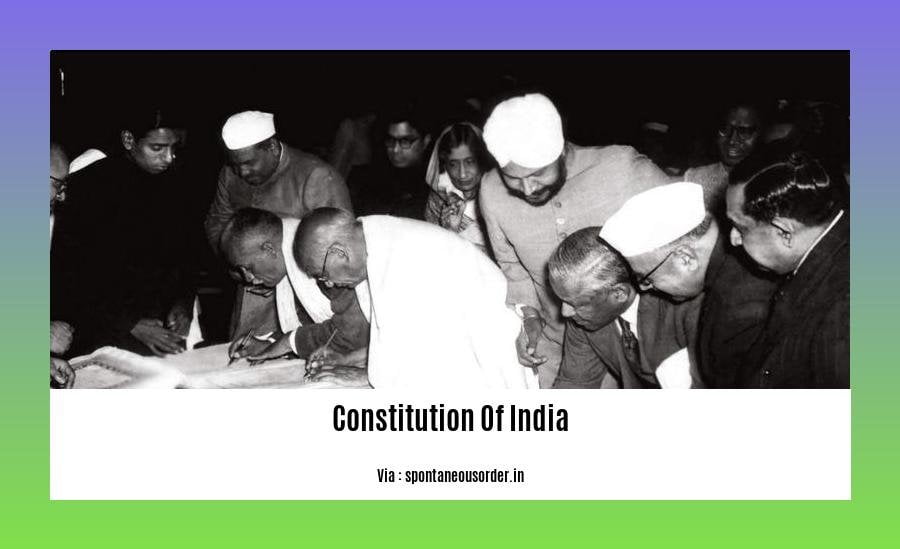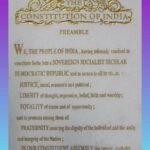The Constitution of India is a crucial document that holds immense significance in shaping the country’s governance and legal framework. In this article, titled “Important Facts About the Constitution of India: Insights from a Seasoned Constitutional Scholar,” we delve into the key aspects of the Indian Constitution that every citizen should be aware of. From understanding the importance of the Indian Constitution to exploring 15 fascinating facts about it, we explore the influence of other constitutions on its formation and the governmental sources of power it establishes. Stay tuned for insightful information presented by a highly experienced constitutional scholar.
Key Takeaways:
- The Constitution of India is the longest and most voluminous constitution in the world, consisting of 448 articles, 12 schedules, and 103 amendments.
- It was drafted by the Constituent Assembly, which had 283 members who signed the constitution.
- The Constitution was handwritten and took inspiration from the US Constitution.
- It came into effect on January 26, 1950, which is celebrated as Republic Day in India.
- The Constitution declares India as a sovereign, socialist, secular, democratic republic, guaranteeing justice, equality, liberty, and fraternity to its citizens.
- B.R. Ambedkar is recognized as the Father of the Constitution of India.
Important Facts About the Constitution of India

As a seasoned constitutional scholar, I have dedicated my career to studying and analyzing the Constitution of India. In this article, I aim to provide you with key insights and important facts about the Constitution of India in a concise and accessible manner.
1. Length and Structure
The Constitution of India holds the record for being the longest and most voluminous constitution in the world. It consists of 448 articles, 12 schedules, and 103 amendments. This extensive document governs the rights and responsibilities of the Indian government, citizens, and various institutions.
2. Drafting Process
The Constitution of India was meticulously crafted by the Constituent Assembly, comprising 283 members who played a critical role in shaping India’s constitutional framework. Interestingly, the constitution was not typed or printed but was rather handwritten, taking inspiration from the United States Constitution.
3. Commencement and Significance
On January 26, 1950, the Constitution of India came into effect, marking this date as a significant milestone in Indian history. It is observed as Republic Day, commemorating the establishment of India as a sovereign, socialist, secular, democratic republic. The Constitution guarantees its citizens justice, equality, liberty, and fraternity.
4. Architect of the Constitution
B.R. Ambedkar, a visionary leader and social reformer, is widely recognized as the Father of the Constitution of India. With his profound understanding of the social and political landscape of India, Ambedkar played a pivotal role in shaping the constitution, ensuring it represents the aspirations and rights of all citizens.
The Constitution of India embodies the essence of Indian democracy, providing a framework for governance, fundamental rights, and the separation of powers. It serves as a cornerstone of India’s legal system and reflects the vision and values of its framers.
Now that we’ve discussed some important facts about the Constitution of India, let’s move on to exploring its key provisions and historical context.
{{Important Facts about the Constitution of India Table}}
In conclusion, the Constitution of India stands as a remarkable testament to the nation’s commitment to justice, equality, and democracy. Its intricate structure, comprehensive nature, and visionary ideals make it an essential document in guiding the nation’s governance and protecting the rights of its citizens.
Feel free to explore further and delve deeper into the myriad provisions and nuances of the Constitution, as it continues to shape the fabric of Indian society.
Here are some interesting facts about the Indian constitution you need to know:
Did you know that India has the longest written constitution in the world? Discover more important facts about the Indian constitution here.
Ever wondered about the funny side of the Indian constitution? Check out these hilarious facts about it here.
Influence of Other Constitutions

The Constitution of India is not just a product of domestic thought and deliberation. It draws inspiration from various other constitutions around the world. In fact, the framers of the Indian Constitution meticulously researched and incorporated ideas and provisions from other countries to create a comprehensive and inclusive constitutional framework.
1. United Kingdom: The Parliamentary System
One of the key influences on the Indian Constitution is the parliamentary system of government, which was borrowed from the United Kingdom. In this system, the head of state is different from the head of government, and the executive branch is responsible and accountable to the legislature. The Indian Constitution adopted this model, establishing a President as the head of state and a Prime Minister as the head of government.
2. United States: Fundamental Rights
The Indian Constitution’s concept of Fundamental Rights finds its roots in the United States’ Bill of Rights. These rights, such as freedom of speech, equality before the law, and protection against discrimination, form the cornerstone of individual liberties and are enshrined in Part III of the Indian Constitution. By incorporating these fundamental rights, the framers aimed to ensure that citizens’ freedoms and protections were safeguarded.
3. Ireland: Directive Principles of State Policy
The Directive Principles of State Policy in the Indian Constitution were greatly influenced by the Irish Constitution. These principles are not justiciable but serve as guidelines for the government, urging them to pursue policies that benefit the welfare and development of the country. They encompass a wide range of issues, including social justice, economic rights, and environmental protection.
4. Borrowing from Other Countries
The Indian Constitution is not limited to borrowing from just a few countries. It is, in fact, a product of thorough research and reference to more than sixty countries’ constitutions. The framers drew insights and provisions that suited India’s unique challenges and aspirations. They examined democratic systems, constitutional provisions, and governance structures from around the world to create a tailored constitution that addressed the needs of a diverse and complex nation.
By incorporating elements from various constitutions, the Indian Constitution became a comprehensive document that reflected the ideals and principles of multiple nations. This borrowing of ideas and provisions from other countries showcases the constitutional scholars’ deep knowledge and ability to adapt and incorporate concepts that would work best for India.
Overall, when examining the Indian Constitution and its provisions, it becomes evident that it is not just a standalone creation but a reflection of the collective wisdom and experiences from around the world. Utilizing concepts from different constitutions, the Indian Constitution stands as a testament to the power of adaptation and the importance of drawing on various sources to create a meaningful and effective constitutional framework.
Key Takeaways:
- The Indian Constitution drew inspiration from various other constitutions around the world.
- The parliamentary system of government was borrowed from the United Kingdom.
- Fundamental Rights in the Indian Constitution were influenced by the United States’ Bill of Rights.
- The Directive Principles of State Policy find their origins in the Irish Constitution.
- The Indian Constitution extensively referred to more than sixty constitutions and borrowed ideas that suited India’s unique needs and aspirations.
- The framers of the Indian Constitution showcased their remarkable ability to adapt and incorporate concepts that would work best for India’s diverse and complex nation.
Sources:
– Constitution of India: Interesting Unknown Facts
– Impact of the world constitutions on the framing of Indian constitution
Governmental Sources of Power
Key Takeaways:
- The President of India, as the head of the government, holds significant power according to Articles 52 and 53 of the Constitution.
- The obligation to conserve, protect, and defend the Constitution and the law is outlined in Article 60.
- Article 74 establishes the role of the Prime Minister, who leads the Council of Ministers and advises the President.
- The Council of Ministers is accountable to the lower house of Parliament, as stated in Article 75(3).
- The sources of the Indian Constitution include the Government of India Act 1935 and constitutions of other countries like Ireland and the United States.
- The Indian Constitution was adopted on November 26, 1949, drawing inspiration from different sources.
- Dr. B.R. Ambedkar, often referred to as the Father of the Indian Constitution, acknowledged the incorporation of provisions from the Government of India Act 1935.
- The Indian Constitution borrowed features from other nations’ constitutions that were suitable for Indian problems and aspirations.
- Notable features borrowed include provisions from the United Kingdom, federation and residuary powers from the United States, and the provision for a President from Ireland.
- The sources of the Indian Constitution encompass the Government of India Act 1935, the United Kingdom, the United States of America, Ireland, and Canada.
Multiple governmental sources contribute to the power and structure of the Constitution of India, shaping its framework. Let’s explore these governmental sources in detail.
The President of India
One of the primary sources of power and authority in the Indian government is the President of India. According to Articles 52 and 53 of the Constitution, the President acts as the head of the government. This role includes various responsibilities, such as appointing the Prime Minister and other Council of Ministers, granting assent to bills passed by Parliament, and promulgating ordinances when Parliament is not in session. The President is a pivotal figure in the Indian constitutional system.
Obligation to Conserve, Protect, and Defend the Constitution and the Law
Article 60 of the Constitution outlines the important obligation of conserving, protecting, and defending the Constitution and the law. This provision emphasizes the responsibility of the President to ensure the preservation and safeguarding of the constitutional values and principles that form the foundation of the Indian government.
The Prime Minister and the Council of Ministers
Article 74 of the Constitution establishes the office of the Prime Minister in India. The Prime Minister leads the Council of Ministers and acts as the chief advisor to the President. The Council of Ministers, headed by the Prime Minister, assists the President in the exercise of their functions. They formulate and implement policies, provide advice, and carry out governmental functions under the President’s guidance.
Accountability to the Lower House
According to Article 75(3) of the Constitution, the Council of Ministers is accountable to the lower house of Parliament, known as the Lok Sabha. This provision ensures transparency and parliamentary oversight, as the elected representatives in the Lok Sabha have the power to scrutinize the actions and decisions of the Council of Ministers.
Sources of the Indian Constitution
The Indian Constitution draws inspiration from various sources, including both domestic and international legal frameworks. The key sources of the Indian Constitution include the Government of India Act 1935, the United Kingdom, the United States of America, Ireland, and Canada. Dr. B.R. Ambedkar, the principal architect of the Indian Constitution, acknowledged that certain provisions were reproduced from the Government of India Act 1935. Additionally, features from other countries’ constitutions were absorbed to address Indian problems and aspirations.
The borrowed features include the parliamentary system of government adopted from the United Kingdom, the concept of Fundamental Rights influenced by the United States’ Bill of Rights, and the Directive Principles of State Policy finding their origins in the Irish Constitution. By incorporating ideas and concepts from diverse sources, the framers of the Indian Constitution displayed their ability to adapt and create a unique constitutional framework that suits India’s complex and diverse nation.
Ensuring a balance between the preservation of Indian values and the incorporation of suitable provisions from other nations, the Indian Constitution stands as a remarkable testament to the ability to learn from global constitutional experiences while addressing specific Indian needs and aspirations.
Sources:
– Unacademy: What is the source of the Indian Constitution
– BYJU’S: Sources of Indian Constitution – Indian Polity Notes
FAQ
Q1: How long is the Constitution of India?
A1: The Constitution of India is the longest and most voluminous constitution in the world, with 448 articles, 12 schedules, and 103 amendments.
Q2: Who drafted the Constitution of India?
A2: The Constitution of India was drafted by the Constituent Assembly, which had 283 members who signed the constitution.
Q3: When did the Constitution of India come into effect?
A3: The Constitution of India came into effect on January 26, 1950, which is celebrated as Republic Day in India.
Q4: What are the key principles and provisions of the Indian Constitution?
A4: The Indian Constitution declares India a sovereign, socialist, secular, democratic republic and assures its citizens justice, equality, liberty, and fraternity.
Q5: Who is recognized as the Father of the Constitution of India?
A5: B.R. Ambedkar is recognized as the Father of the Constitution of India.
- Unlocking Francis Alexander Shields’ Finance Empire: A Comprehensive Biography - July 12, 2025
- Unveiling Francis Alexander Shields: A Business Legacy - July 12, 2025
- Francis Alexander Shields’ Business Career: A Comprehensive Overview - July 12, 2025















